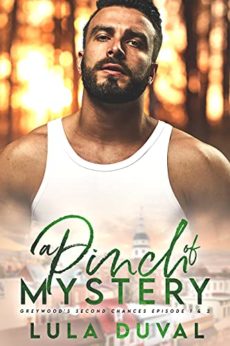 A Pinch of Mystery: Episode 1 & 2
A Pinch of Mystery: Episode 1 & 2 Greywood's Second Chances
LGBTQ Action Adventure/Romance/Mystery
Independently Published
April 27, 2021
225

Ready for your next romantic, wild, fun ride? Discover this new serial full of small-town shenanigans and second chances!!
Codey:
I still have it bad for Fallon Brown, even though he probably hired a hitman the minute he heard I was back in town.
My life is a mess. My brother ran away and left me in charge of our sick dad. My best friend Fallon, a.k.a. the love of my life I betrayed years ago, hates my guts. To top it all off, I’m broke. The only way for me to give my father the medical help he needs is to sell Harold Cronunberg’s house: the biggest, fanciest house on the market. Unfortunately, to do that, I’d have to double-cross Fallon once again. And this time, I could lose him forever.
Fallon:
Codey F*cking Fellini is back in Greywood, and he wants to steal my house? Hell no.
Apparently, it wasn’t enough for the barbarian to shatter my heart into pieces twelve years ago. No, he needed to show up unannounced to ruin my life again. Well, I, Fallon Benjamin Williams Brown, will make sure this doesn’t happen. I am Greywood’s official realtor. This snack of a man is going to stay as far away as possible from me, my heart, and what’s in my pants… and the house, too.
A Pinch of Mystery is the first installment in the new serial: Greywood’s Second Chances. The series will follow Fallon and Codey as they give their love, their lives, and themselves a second chance.

Reviewed by Ulysses Dietz
Member of The Paranormal Romance Guild Review Team
I need to embrace my three-star reviews again, and to underscore the truth that three stars from me doesn’t mean you shouldn’t read a book. I enjoyed this. It is intentionally silly and absurdist in the way the author writes and structures the story. Set in a fictional small town in Ontario, comically dubbed Greywood to suggest both the dullness of the place and the constant dreary weather, it’s kind of like the charming town in which the hit TV series Gilmore Girls was set, except not.
The story itself plays out like a mashup amongst “I Love Lucy” (if Lucy and Ethel were a couple), “Happy Days” (if Richie and Potsie were boyfriends), and “Tom & Jerry” (also a couple, Fallon being the cute but mischievous little mouse and Codey the nefarious but inept cat). If that seems like a strange simile, there you go.
In the course of the two episodes included in this book, there are two mysterious deaths, that for some inexplicable reason, Fallon and Codey get dragged into. This goes on top of the fact that Fallon and Codey, at the start of the book, have not seen each other in a dozen years.
Fallon Brown is Greywood’s only realtor, although that apparently doesn’t amount to much, because who wants to live here, right? At thirty, he finds himself in a tough spot, because his neglectful, alcoholic mother died, leaving him piles of gambling debts as well as his unhappy childhood to remember.
Codey, also thirty, is back in town after all this time because his aging father is beginning the slide into dementia, and Codey feels compelled to abandon his life in Toronto to care for his gay dad. His other gay dad died of AIDS when Codey was six, and his older brother has taken off, leaving his father alone. Oh, yes, Codey is a recovering drug addict and alcoholic.
Not that any of this rather dark background gets much page time, because not only do Codey and Fallon fall back into each other’s arms pretty readily, but they set off on a series of madcap murder-and-real-estate adventures that concentrate mostly on their strong physical attraction to each other, while introducing the reader to the various oddball denizens of Greywood.
Come to think of it, there’s rather a lot of “The Andy Griffith Show” in this scenario, too. Which, of course, is where Ron Howard got his start in Hollywood before “Happy Days” made him a sort of superstar.
Author Lula Duval (whose name suggests that she could live in Greywood herself) has invested this story with a lot of potential trauma to explore; both Fallon and Codey are damaged young men, a classic trope for m/m romances that can be both literarily effective and highly moving for the reader. I’m not entirely sure why the author, in choosing a more comedic approach to the story, decided on an antic tone that consistently fights the unhappiness woven throughout the book’s various subplots and unhappy characters.
Having recently read Leta Blake’s flawed but compelling “Vespertine,” which has a similarly fraught set of subplots, I can’t help but wonder, in the end, if Ms. Duval couldn’t have embraced the darkness in her story a little more. It is possible to laugh and cry at the same time.
